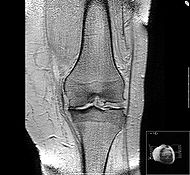User:J griffin/Osteoarthritis and Aerobic Exercise
Aerobic Exercise in the Treatment of Osteoarthritis[edit | edit source]

Brief Background[edit | edit source]
Osteoarthritis is the most common form of arthritis, affecting millions of people around the world (Doherty, Roddy, Zhang, 2005). In Australia alone, it is estimated that there are approximately 3.85 million people living with osteoarthritis; that is 1 in 5 people with the disorder, with 61.3% of these being women. In a typical joint, the ends of the bone are covered by a layer of cartilage that protects and cushions the bones. In osteoarthritis, this cartilage breaks down leaving the bones of the joint unprotected causing friction within the joint which may cause pain and can limit mobility. While osteoarthritis can affect any joint, the disorder most commonly affects joints in your hands, neck, spine, knees, feet and hips (Doherty, Roddy, Zhang, 2005).
Explanation of the Issue[edit | edit source]
Osteoarthritis is characterised by the following symptoms
- Swelling, warmth and creaking of the joint
- Recurring pain with movement
- Aches from weather changes
- Pains and stiffness form long periods of inactivity
- Limited range of motion
- Muscle weakness
- An abnormal growth of bony knobs near the joints
While there is no cure for osteoarthritis, there is multiple lifestyle modifications that can be made to delay the onset and reduce the effects of osteoarthritis. Along with dietary changes, an increase in activity levels may help individuals manage their symptoms. Regular exercise may facilitate in the strengthening of the muscles surrounding the joints providing support and stability and improving functional capacity of the individuals.
Many studies have researched the benefits of aerobic exercise in the management of those with osteoarthritis, finding that if done appropriately, participants reported improvements in each of the following
- Aerobic capacity (Westby 2001)
- Decreased depression and anxiety ( Westby 2001)
- Increased physical activity (Westby 2001)
- Increased muscular strength (Westby 2001)
- Decreased pain (Westby 2001)
- Increase of functionality (Kovar 1992)
| Osteoarthritis | |
|---|---|
| Classification and external resources | |
 Osteoarthritis is most commonly found in the knee |
Recommendations[edit | edit source]
It is recommended that individuals should:
- Avoid high impact activities that place stress on the joints
- Participate in gentle exercises including walking, biking and swimming, water exercise
- Since pain may increase with exercise, adequate rest is advised to reduce the likelihood of this, however a compromise between rest and activity needs to be met to ensure that an increase in joint stiffness is not acquired through lack of physical activity
- Incorporate exercise into the daily routine through activities such as vacuuming, house work and gardening
- Start slowly, do 10 minutes of activity at a time, 1 or 2 times a day. Then slowly increase work your physical activity. Aim for at least 2½ hours of moderate activity a week.
Further Reading/ Information Sources[edit | edit source]
For further information on osteoarthritis
- http://www.medicinenet.com/osteoarthritis/article.htm
- http://www.emedicinehealth.com/osteoarthritis/article_em.htm
- http://www.betterhealth.vic.gov.au/bhcv2/bhcarticles.nsf/pages/Osteoarthritis
- Katzenstein, Larry 2005, Taking charge of arthritis: A practical guide to managing your health and wellbeing, Readers Digest Australia, Ultimo, NSW
- Arthritis Australia: Email: info@arthritisaustralia.com.au , freecall: 1800 111 101
- See your doctor or other health care practitioner
References[edit | edit source]
Burns, R. (1997)“A Randomized Trial Comparing Aerobic Exercise and Resistance Exercise With a Health Education Program in Older Adults With Knee Osteoarthritis.” The Journal of the American Medical Association, 277 (1): 25-31.
Clyman, B. (2001). “Exercise in the treatment of osteoarthritis.” Current Rheumatology Reports, 6(3): 520–523.
Doherty, M., Roddy, E., Zhang, W. (2005) “Aerobic walking or strengthening exercise for osteoarthritis of the knee?” Annals of the Rheumatic Diseases, 64 (4): 544-548
Jansen, M. Viechtbauer, W. Lenssen, A. Hendriks. (2011) “Strength Training Alone and Exercise Therapy with Passive Manual Mobilisation Each Reduce Pain and Disability in People With Knee Osteoarthritis.” Journal of Physiotherapy, 57 (1) : 11-21
Kovar, P.A., Allegrante, J.P., MacKenzie, R., Peterson, M.G.E., Gutin, B., Charlson, M.E. (1992) “Supervised Fitness Walking in Patients with Osteoarthritis of the Knee.” Annals of Internal Medicine, 116(7):529-534.
Krasilshchikov, O. Sungkit, N.B. Shihabudin, T. Shaw, I. Shaw, B (2011) “ Effects of an Eight Week Training Programme on Pain Relief and Physical Condition of Overweight and Obese Women with Early Stage Primary Knee Osteoarthritis.” African Journal for Physical, Health Education, Recreation and Dance, 17 (2):328-340.
Marian, A. (2005) “Efficacy of physical conditioning exercise in patients with rheumatoid arthritis and osteoarthritis.” American College of Rheumatology, 32 (11): 1396-1405.
Meyer, M (1996) “Joint Efforts”. Women’s Sport and Fintness, 18 (3): 81-84
Minor, M.A., Hewett, J.E., Webel, R.R., Anderson, S.K., Day, D.R. (1989) “Efficacy of Physical Conditioning Exercise in Patients with Rheumatoid Arthritis and Osteoarthritis.” Arthritis and Rheumatism, 32(11):1396-1405
Westby, M.D. (2001)”A Health Professional's Guide to Exercise Prescription for People with Arthritis: A Review of Aerobic Fitness Activities.” Arthritis Care & Research, 45:501-511.
- ↑ "WHO Disease and injury country estimates". World Health Organization. 2009. Retrieved Nov. 11, 2009.
{{cite web}}: Check date values in:|accessdate=(help)